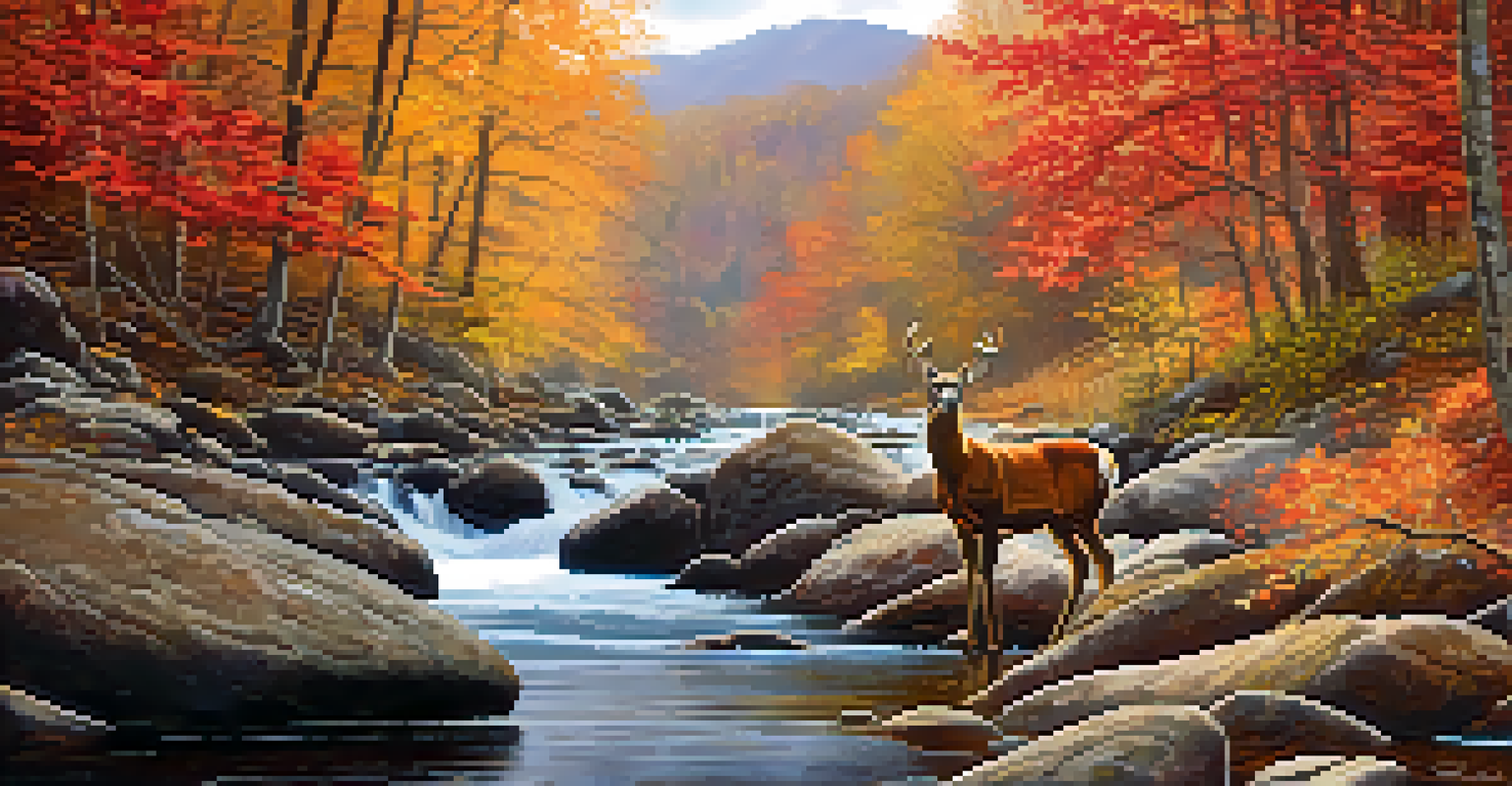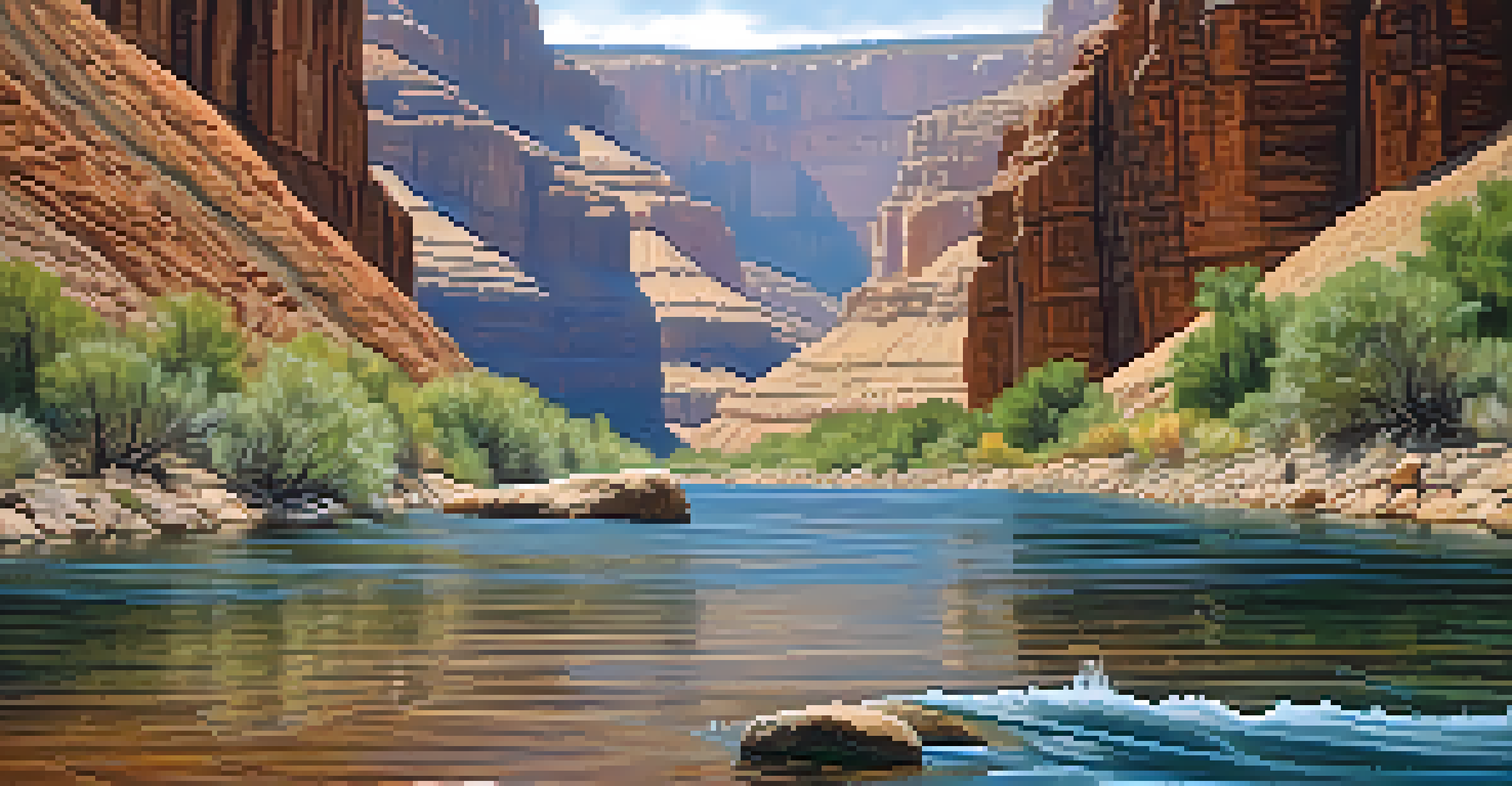Wildlife Watching: Nature Spots Near Mountains and Rivers

Why Mountains and Rivers Are Ideal for Wildlife Watching
Mountains and rivers create unique ecosystems that attract diverse wildlife. The varying elevations and water sources provide habitats for many species, from majestic eagles soaring above to playful otters swimming below. This blend of terrains allows for a rich tapestry of life, making it an ideal destination for nature enthusiasts.
In every walk with nature one receives far more than he seeks.
When you visit these areas, you often encounter animals in their natural behaviors, whether it’s bears foraging in the woods or deer grazing near riverbanks. These interactions offer a thrilling experience for wildlife watchers, as you get to see the beauty of nature unfold before your eyes. The variety of environments also means that different species are active at different times, ensuring there's always something to observe.
Moreover, the serene backdrop of mountains and flowing rivers enhances the wildlife watching experience. The sounds of rustling leaves, flowing water, and distant animal calls create a captivating symphony that complements the visual spectacle, making each outing unforgettable.
Top Mountain Locations for Wildlife Watching
One of the most stunning mountain ranges for wildlife watching is the Rocky Mountains. In places like Rocky Mountain National Park, you can encounter elk, bighorn sheep, and even the elusive mountain lion. The park's diverse habitats, from alpine tundra to lush forests, provide excellent opportunities to see these magnificent creatures in their natural environment.

Another gem is the Sierra Nevada, known for its striking landscapes and rich biodiversity. Areas like Yosemite National Park are not only famous for their breathtaking views but also for their wildlife, including black bears and golden eagles. The combination of towering cliffs and verdant valleys makes it a prime spot for nature lovers.
Mountains and Rivers Foster Wildlife
The diverse ecosystems created by mountains and rivers attract a wide variety of wildlife, making these areas ideal for observing animals in their natural behaviors.
Lastly, the Appalachian Mountains offer a different kind of experience. With lush forests and abundant streams, spots like the Great Smoky Mountains National Park are home to over 19,000 documented species, including deer, foxes, and a variety of birds. The unique flora and fauna found here provide an engaging backdrop for observing wildlife.
Best Rivers for Wildlife Observation
Rivers serve as vital arteries of life, and the Mississippi River is one of the best places to witness this. The river's wetlands are home to a plethora of wildlife, including migratory birds, fish, and various mammals. Observing the seasonal changes can reveal new species at different times of the year, making each visit a unique experience.
The Earth has music for those who listen.
Another exceptional river for wildlife watching is the Yellowstone River in Wyoming. This river flows through one of the most famous national parks, attracting visitors keen to spot bison, wolves, and grizzly bears. The interplay of riverine habitats and surrounding landscapes creates a dynamic environment where wildlife thrives.
The Colorado River is also noteworthy, especially in the Grand Canyon. Here, you can see river otters playing in the water and numerous birds nesting along the cliffs. The dramatic scenery combined with diverse wildlife makes it a perfect spot for both adventure and observation.
Timing Your Wildlife Watching Adventure
Timing is critical when it comes to wildlife watching. Early mornings and late afternoons are typically the best times to spot animals, as they are most active during these cooler parts of the day. Planning your outings around these times increases your chances of seeing wildlife in action, whether it's a bear waking up from its slumber or birds taking to the sky.
Seasonal changes also influence wildlife behavior. For instance, spring is an excellent time for birdwatching, as many species return from migration and begin nesting. In contrast, fall is when animals like deer are more active during the day as they prepare for the winter months. Understanding the seasonal patterns enhances your wildlife experience significantly.
Timing Enhances Wildlife Encounters
Being mindful of the best times to watch wildlife, including early mornings and late afternoons, can significantly increase your chances of spotting animals.
Lastly, patience is key. Sometimes, it may take a while to spot wildlife, so bringing along a book or camera to enjoy the scenery can keep you engaged while you wait. Being attentive to your surroundings will often reward you with unexpected sightings.
Essential Gear for Wildlife Watching
Having the right gear can make all the difference in your wildlife watching experience. A good pair of binoculars is essential; they allow you to observe animals from a distance without disturbing them. Look for binoculars with good magnification and a wide field of view to catch all the action.
A field guide specific to the region you’re visiting can also enhance your experience. These guides help you identify species and learn more about their behaviors and habitats. Whether it’s a book or a mobile app, having this resource at your fingertips can turn a casual outing into a rich learning experience.
Lastly, don’t forget about comfort and safety. Wear appropriate clothing for the weather, sturdy footwear for hiking, and carry essentials like water and snacks. Being prepared ensures that you can focus on the joy of watching wildlife without any distractions.
Respecting Wildlife and Their Habitats
Respecting wildlife and their habitats is paramount when engaging in wildlife watching. Keeping a safe distance is crucial; getting too close can stress animals and disrupt their natural behaviors. Use binoculars or a camera with a zoom lens to observe without intruding on their space.
Additionally, always follow local guidelines and regulations regarding wildlife observation. Many parks have specific rules in place to protect both visitors and animals. Adhering to these rules not only ensures your safety but also preserves the delicate balance of these ecosystems for future generations.
Respect Nature While Observing
Maintaining a safe distance and following local guidelines is essential for protecting wildlife and their habitats during your wildlife watching adventures.
Finally, leave no trace. Pack out what you pack in, and be mindful of your surroundings. Simple actions like staying on designated trails and not feeding wildlife go a long way in maintaining the integrity of these beautiful natural spaces.
Capturing Your Wildlife Watching Memories
Capturing your wildlife watching experiences is a great way to relive those magical moments. Consider bringing a camera with a good zoom lens to document your encounters. Whether it’s a stunning shot of a soaring eagle or a candid moment of a deer in the woods, these photos can serve as cherished memories.
Journaling is another fantastic way to keep track of your observations. Note down the animals you see, their behaviors, and the locations where you spotted them. This practice not only enhances your experience but also contributes to a deeper understanding of wildlife.

Lastly, share your experiences! Whether through social media, blogs, or community groups, sharing your wildlife watching stories inspires others to explore nature. By building a community of nature lovers, you can foster a greater appreciation for wildlife and the importance of conservation.